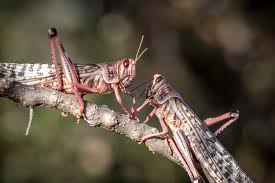Sweet smell of plague - A step towards preventing locust swarms
Review
Anandarup Bhadra
 Credits: Pexels
Credits: Pexels
In 2020, western and central India saw the sky blackened by millions of desert locusts (Schistocerca gregaria), a haunting image out of the Biblical plagues. These swarms can be upto a few kilometers long and can wipe out several fields of crops in a single day. They are a threat to the food and livelihood of millions of people[1]. Recently, Xiaojiao Guo and her colleagues made some crucial discoveries in understanding how locusts aggregate, as reported in a study in Nature, “4-vinylanisole is an aggregation pheromone in locusts”[2]. This may provide better strategies to deal with locust swarms, a crisis that revisits us once every few decades.
Tweet
Scientists from the Chinese Academy of Sciences have identified a pheromone (a chemical signal used for communication by some animals in certain circumstances, very similar to our use of soundwaves while talking) 4-vinylanisole (4VA) produced by the migratory locust (Locusta migratoria). We must note that it is a different species, but it also forms swarms. Although such a molecule is a source of sweet smell for us, this is the first pheromone that fits all the criteria to work as an aggregation pheromone in locusts.
Locusts show two distinct phases as adults[3] - one solitary, which is peaceful and harmless, and the other aggressive, capable of eating their own body weight in food and appearing in almost endlessly large groups. Aggregation pheromones[4] are molecules that insects can detect (like odorants or smell molecules in our case) that induce group formation by bringing many individuals of both sexes, multiple life stages and ages together. Such pheromones may have a crucial role in the transition of locusts from a solitary form to the devastating gregarious form and the formation of enormous swarms.
In this comprehensive study, the scientists identified six prospective chemicals from 35 released by the migratory locusts by testing which of them are produced in higher amounts in the gregarious phase, but not in solitary insects. Out of the 6, 4-vinylanisole was highly effective in attracting both solitary and gregarious locusts (including male and female locusts at both juvenile and adult developmental stages). This suggests that the ability to sense this proposed aggregation pheromone is an innate characteristic of these locusts.
Scientists found that 4VA production can be triggered even in solitary insects by their aggregation. In fact, this response may be triggered by the grouping of locusts as few as four or five. They also confirmed that the pheromone elicits responses specifically from sensory hairs on the antennae of the locusts.
The researchers identified a receptor OR35[5] which, when absent, renders the locusts unable to respond to 4VA. The receptor OR35 may be used to identify compounds that block the activity of 4VA. Such molecules might be used to force locusts to return to the solitary phase from the gregarious phase and thus prevent swarming.
Finally, to confirm that 4VA indeed works as an aggregation pheromone the researchers used it as bait to successfully trap both experimental and wild populations of migratory locusts.
It is unclear to what extent 4-vinylanisole plays a role in forming swarms beyond triggering this initial aggregation. Further investigation is needed to determine whether other pheromones are also involved in this process. More importantly, this whole line of research has to be validated for desert locusts to ensure that it may become useful for the prevention of their large scale invasions and the resulting losses suffered by the people from parts of Africa, across the middle east, to India.
The pheromone can potentially be used as bait to lure and trap locusts, both solitary and gregarious. This would be a better way to control their numbers[6] in the wild without the use of pesticides. In a few years, this work promises to uncover ways of using the locusts' own mechanism for forming swarms to neutralise their capacity for becoming a menace to society.
Bibliography
Anandarup Bhadra is a teacher and an educator. He has a background in animal behaviour research and currently engages in various scientific outreach and citizen science projects.
signup with your email to get the latest articles instantly